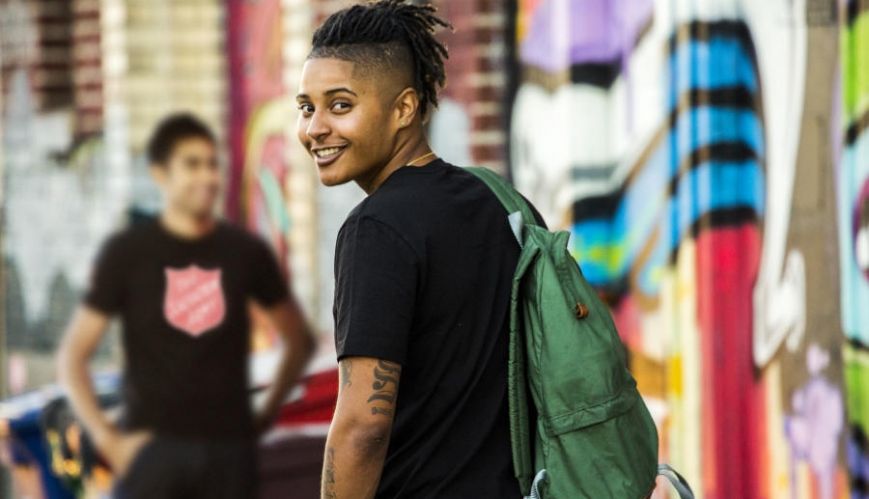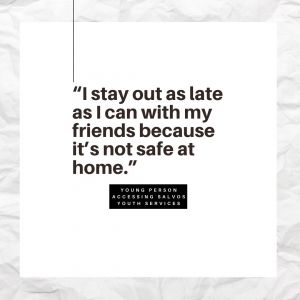Youth Homelessness Matters day

Youth Homelessness Matters day
21 April 2021
Stock image.
Youth Homelessness Matters Day (21 April 2021) aims to raise awareness and public discussion about youth homelessness so that together, we can develop sustainable and innovative solutions for not only assisting young people experiencing homelessness but also supporting their life hopes and dreams.

The Salvation Army believes that having safe, secure and affordable housing is a human right. Our services are here to listen to and assist young people, and support them on their unique journey to independence and community.
One in six young people in Australia, aged between 12 and 24, have experienced homelessness (Mission Australia 2020).
These young people come from a range of cultural backgrounds, socio-economic groups, cities, regions and communities. They come overwhelmingly from homes that range from the uncomfortable to distressing and dangerous. Some have limited support and community connection. Others have nobody. And nothing. Many are struggling with the impacts of trauma, abuse, neglect and addiction. They are looking for safety, acceptance, connection and a place to belong.
Salvos services
Burlendi, Adelaide, is an emergency accommodation service for young people aged 15-18. “We make sure young people are safe,” explains Stuart Moerman, manager at Burlendi. “We can then assist them with the needs they identify, such as health and medical issues, engaging with school, reconnecting with family, independent living skills, education or employment.”
Stuart and his team work closely with Odir Galdamez, case manager at the nearby Salvos Ingle Farm Youth Accommodation Service for singles, couples, family units and partners aged 15-25. “Our case management focuses on helping young people work on their goals, getting them settled in group living or returning to family as appropriate,” says Odir.
Each week from Leongatha Salvos, 135km south-east of Melbourne, the three case managers in Specialist Youth Services receive referrals for youth aged 15-25. The team engages quickly with each young person. “We answer their questions and go through options and what specialist case management and longer-term support we can offer,” says Case Manager, Siobhan Paxton.
There are also options for young people still at home.
“We support the young people around conflict resolution and building relationships with their parents so they can remain in the home,” says Case Manager, Brenda Stewart. “For those who leave, we assist with emergency accommodation, developing life skills and, as appropriate, preparing them to transition into the private rental market.”
Myths

“I can’t focus on school when I’m always hungry.”
“I stay out as late as I can with my friends because it’s not safe at home.”
“I just never know what I will find when I go home, or what will happen to me.”
These are just a handful of comments from young people who have received help from Salvos Youth Services. Behind the overwhelming majority of these young people is a story – a story that is not their own, but those of their families or the significant adults in their lives.
“Rarely do we meet young people who are experiencing homelessness through their own fault or choice,” says Siobhan. “They are impacted by the mental health issues of their families, or issues around family violence, alcohol, drugs and family breakdowns.”
Brenda explains that, when the young person chooses to leave a toxic environment, they are often labelled as lazy or just not wanting to follow the rules of the family. “They are seen as having made their own choice to leave and are not given support,” she says. “Parents and others may say that the door is always open, but it’s far from an ideal environment, and always a struggle for the young person.”
In the youth homelessness sector, the very few young people who do have a safe and appropriate home, are recognised quickly and assisted to return to their families.
Couch surfing
Many people also believe that, if a young person has a roof over their head, they are not experiencing homelessness, even if they are sleeping on the couches of different friends or relatives for long periods of time. “Couch surfing is still homelessness and it impacts on the lives of young people as they do not have a safe and permanent place they can call home,” says Brenda.
Having a secure home and community is paramount for young people.
“Even when a young person becomes homeless, they still want to be part of a community and belong somewhere,” explains Stuart. “Couch surfing, squats and emergency accommodation are communities of sorts themselves. There can be a perception that it’s a gang or bunch of delinquents, but really, it’s a group of young people who want to be in a community, belong, and not face more rejection.”
What can we do?

Despite the complexity and growth of youth homelessness, those in the sector believe there is much that can be done to alleviate the struggles young people are experiencing.
“Lack of affordable housing is the biggest problem we face,” says Stuart. “Young people couch surf and sleep rough because there is simply a lack of youth-specific housing and services. They can’t get their education if they’re not safe or sleeping. Some of our amazing young people say the thing they like best about all that our services offer, is that they can lock their doors and feel safe.”
Young people also need improved financial assistance.
“We need to see an increase in the Youth Allowance, so young people don’t have to live in poverty and can afford the basics of life,” says Brenda. “We also need to go deeper, to interventions in the early and pre-teen years, when we see conflict in the home. If issues can be addressed with families then, before it gets to broken relationships, then fewer young people will end up experiencing homelessness with no family around them.”
Odir believes that upskilling teachers, other students and the broader community to help them understand what home looks like for many young people, and how it impacts them, is important, as well as changing the media narrative and its portrayal of young people.
Similarly, Stuart says we need to change the language we use and reframe homelessness. “Homelessness is not something that should define people,” he emphasises. “Everyone has a story and there is a reason why they are couch surfing. Home might be super unsafe so they can’t sleep, their step-dad is drinking or there is constant fighting. Let’s get educated on this and challenge the labels we use.”
Connecting the youth to the community is also key. “I go to the youth group [the Salvos] run for our young people and just hang out with them,” says Odir. “It’s a genuine connection, not as just a worker. There are also camps and cool events, social pathways and connections to the church. Our youth need connection with the whole community, not just social services.”
If young people feel understood, it gives them hope and encouragement.
“So many of the barriers they face just wear them down to the level of ‘What’s the point?’,” explains Siobhan. “So many people are making generalisations about them, housing is much less affordable and available than it was, there are fewer entry-level jobs, government payments keep them below the poverty line … you can’t concentrate if you’re hungry or don’t know where to sleep … If we can understand this and not judge, the self-esteem of our young people will definitely improve!”
Motivation
Despite the ongoing challenges of serving in youth homelessness, the joys of the work, and the motivations behind them, drive those involved to continue.
For Odir, it’s all about connection. “It’s about helping young people connect with a community that accepts them, to break the cycle – this is what drives me.”
Brenda loves to see young people achieve something they didn’t think was possible, even if it’s a seemingly simple task. “So many young people don’t have anyone supporting them,” she shares. “I want to be that person – that person who is on their side.”
Seeing young people set and achieve their goals motivates Siobhan. “They are so disadvantaged and don’t have a voice,” she says. “I want to help them navigate the mazes that life throws at them and, in the end, be someone they don’t need anymore!”
Stuart is focused on seeing young people given the opportunities that he experienced as a young person. “Breaking the cycle for these young people in their family lives, work lives, in community, seeing them accepted – this drives me.”
For a full range of Salvos Youth Services, visit salvationarmy.org.au/youthservices
This article first appeared in Salvos Magazine